Nanocomposite Electrode of Titanium Dioxide Nanoribbons and Multiwalled Carbon Nanotubes for Energy Storage
Abstract
1. Introduction
2. Experimental Section
2.1. Materials
2.2. TNRs/CNTs Nanocomposite Fabrication
2.3. Characterization of the Produced Nanomaterials
2.4. Supercapacitor Manufacturing Processes
2.5. Electrochemical Analysis
3. Results and Discussions
3.1. Characterization of the Produced Nanomaterials
3.1.1. Structural Properties
3.1.2. Morphological Analysis
3.2. TNR/CNT Nanocomposite Electrochemical Performance in 1 M H2SO4
3.3. The TNR/CNTs Electrode’s Superior Performance
4. Conclusions
Author Contributions
Funding
Institutional Review Board Statement
Informed Consent Statement
Data Availability Statement
Conflicts of Interest
References
- Kim, B.C.; Hong, J.; Wallace, G.G.; Park, H.S. Recent progress in flexible electrochemical capacitors: Electrode materials, device configuration and functions. Adv. Energy Mater. 2015, 5, 1500959. [Google Scholar] [CrossRef]
- Béguin, F.; Presser, V.; Balducci, A.; Frackowiak, E. Supercapacitors: Carbons and electrolytes for advanced supercapacitors. Adv. Mater. 2014, 26, 2283. [Google Scholar] [CrossRef] [PubMed]
- Wang, F.; Wu, X.; Yuan, X.; Liu, Z.; Zhang, Y.; Fu, L.; Zhu, Y.; Zhou, Q.; Wu, Y.; Huang, W. Latest advances in supercapacitors: From new electrode materials to novel device designs. Chem. Soc. Rev. 2017, 46, 6816–6854. [Google Scholar] [CrossRef] [PubMed]
- Zeyuan, C.; Wei, B. A perspective: Carbon nanotube macro-films for energy storage. Energy Environ. Sci. 2013, 6, 3183–3201. [Google Scholar]
- Chen, H.; Zeng, S.; Chen, M.; Zhang, Y.; Li, Q. Fabrication and functionalization of carbon nanotube films for high-performance flexible supercapacitors. Carbon 2015, 92, 271–296. [Google Scholar] [CrossRef]
- Clement, R.C.; Prasanth, R. Advent of TiO2 nanotubes as supercapacitor electrode. J. Electrochem. Soc. 2018, 165, E345. [Google Scholar]
- Selvakumar, M.; Bhat, D.K. Microwave synthesized nanostructured TiO2-activated carbon composite electrodes for supercapacitor. Appl. Surf. Sci. 2012, 263, 236–241. [Google Scholar] [CrossRef]
- Su, H.; Wang, T.; Zhang, S.; Song, J.; Mao, C.; Niu, H.; Jin, B.; Wu, J.; Tian, Y. Facile synthesis of polyaniline/TiO2/graphene oxide composite for high performance supercapacitors. Solid State Sci. 2012, 14, 677–681. [Google Scholar] [CrossRef]
- Xiang, C.; Li, M.; Zhi, M.; Manivannan, A.; Wu, N. Reduced graphene oxide/titanium dioxide composites for supercapacitor electrodes: Shape and coupling effects. J. Mater. Chem. 2012, 22, 19161–19167. [Google Scholar] [CrossRef]
- Ramadoss, A.; Kim, G.-S.; Kim, S.J. Fabrication of reduced graphene oxide/TiO2 nanorod/reduced graphene oxide hybrid nanostructures as electrode materials for supercapacitor applications. CrystEngComm 2013, 15, 10222–10229. [Google Scholar] [CrossRef]
- Ramadoss, A.; Kim, S.J. Improved activity of a graphene—TiO2 hybrid electrode in an electrochemical supercapacitor. Carbon 2013, 63, 434–445. [Google Scholar] [CrossRef]
- Sankapal, B.R.; Gajare, H.B.; Dubal, D.P.; Gore, R.B.; Salunkhe, R.R.; Ahn, H. Presenting highest supercapacitance for TiO2/MWNTs nanocomposites: Novel method. Chem. Eng. J. 2014, 247, 103–110. [Google Scholar] [CrossRef]
- Ke, Q.; Liao, Y.; Yao, S.; Song, L.; Xiong, X. A three-dimensional TiO2/graphene porous composite with nano-carbon deposition for supercapacitor. J. Mater. Sci. 2016, 51, 2008–2016. [Google Scholar] [CrossRef]
- Yan, L.; Xu, Y.; Zhou, M.; Chen, G.; Deng, S.; Smirnov, S.; Luo, H.; Zou, G. Porous TiO2 conformal coating on carbon nanotubes as energy storage materials. Electrochim. Acta 2015, 169, 73–81. [Google Scholar] [CrossRef]
- Faraji, M. Three-dimensional nanostructures of multiwalled carbon nanotubes/graphene oxide/TiO2 nanotubes for supercapacitor applications. Appl. Phys. A 2016, 122, 697. [Google Scholar] [CrossRef]
- Li, Q.; Zhang, J.; Liu, B.; Li, M.; Liu, R.; Li, X.; Ma, H.; Yu, S.; Wang, L.; Zou, Y.; et al. Synthesis of High-Density Nanocavities inside TiO2-B Nanoribbons and Their Enhanced Electrochemical Lithium Storage Properties. Inorg. Chem. 2008, 47, 9870–9873. [Google Scholar] [CrossRef] [PubMed]
- Wen, J.; Chu, W.; Jiang, C.; Tong, D. Growth of carbon nanotubes on the novel FeCo-Al2O3 catalyst prepared by ultrasonic coprecipitation. J. Nat. Gas Chem. 2010, 19, 156–160. [Google Scholar] [CrossRef]
- Vilaça, P.; Wayne, T. Friction stir welding technology. In Structural Connections for Lightweight Metallic Structures; Springer: Berlin/Heidelberg, Germany, 2011; pp. 85–124. [Google Scholar]
- Li, Y.; Zhang, X.; Luo, J.; Huang, W.; Cheng, J.; Luo, Z.; Li, T.; Liu, F.; Xu, G.; Ke, X.; et al. Purification of CVD synthesized single-wall carbon nanotubes by different acid oxidation treatments. Nanotechnology 2004, 15, 1645. [Google Scholar] [CrossRef]
- Mohamed, S.; Ashraf, A.M.; Abukhadra, M.R. TiO2 nanoribbons/carbon nanotubes composite with enhanced photocatalytic activity: Fabrication, characterization and application. Sci. Rep. 2018, 8, 781. [Google Scholar]
- Wang, Y.; Panzik, J.E.; Kiefer, B.; Lee, K.K.M. Crystal structure of graphite under room-temperature compression and decompression. Sci. Rep. 2012, 2, 520. [Google Scholar] [CrossRef]
- Armstrong, G.; Armstrong, A.R.; Canales, J.; Bruce, P.G. Nanotubes with the TiO2-B structure. Chem. Commun. 2005, 19, 2454–2456. [Google Scholar] [CrossRef] [PubMed]
- Akimoto, J.; Chiba, K.; Kijima, N.; Hayakawa, H.; Hayashi, S.; Gotoh, Y.; Idemoto, Y. Soft-chemical synthesis and electrochemical property of H2Ti12O25 as a negative electrode material for rechargeable lithium-ion batteries. J. Electrochem. Soc. 2011, 158, A546. [Google Scholar] [CrossRef]
- Zhou, W.; Gai, L.; Hu, P.; Cui, J.; Liu, X.; Wang, D.; Li, G.; Jiang, H.; Liu, D.; Liu, H.; et al. Phase transformation of TiO2 nanobelts and TiO2 (B)/anatase interface heterostructure nanobelts with enhanced photocatalytic activity. CrystEngComm 2011, 13, 6643–6649. [Google Scholar] [CrossRef]
- Altowyan, A.S.; Shaban, M.; Abdelkarem, K.; El Sayed, A.M. The Impact of Co Doping and Annealing Temperature on the Electrochemical Performance and Structural Characteristics of SnO2 Nanoparticulate Photoanodes. Materials 2022, 15, 6534. [Google Scholar] [CrossRef]
- Altowyan, A.S.; Shaban, M.; Abdelkarem, K.; El Sayed, A.M. The Influence of Electrode Thickness on the Structure and Water Splitting Performance of Iridium Oxide Nanostructured Films. Nanomaterials 2022, 12, 3272. [Google Scholar] [CrossRef] [PubMed]
- Shaban, M.; Mona, M.; El Sayed, A.M. Structural, optical, and photocatalytic properties of the spray deposited nanoporous CdS thin films; influence of copper doping, annealing and deposition parameters. Mater. Sci. Semicond. Process. 2016, 56, 329–343. [Google Scholar] [CrossRef]
- Gonçalves, N.; Carvalho, J.; Lima, Z.; Sasaki, J. Size–strain study of NiO nanoparticles by X-ray powder diffraction line broadening. Mater. Lett. 2012, 72, 36–38. [Google Scholar] [CrossRef]
- Santara, B.; Giri, P.K.; Imakita, K.; Fujii, M. Evidence of oxygen vacancy induced room temperature ferromagnetism in solvothermally synthesized undoped TiO2 nanoribbons. Nanoscale 2013, 5, 5476–5488. [Google Scholar] [CrossRef] [PubMed]
- Pan, H.; Poh, C.K.; Feng, Y.P.; Lin, J. Supercapacitor electrodes from tubes-in-tube carbon nanostructures. Chem. Mater. 2007, 19, 6120–6125. [Google Scholar] [CrossRef]
- Kim, K.-S.; Park, S.-J. Synthesis and high electrochemical performance of polyaniline/MnO2-coated multi-walled carbon nanotube-based hybrid electrodes. J. Solid State Electrochem. 2012, 16, 2751–2758. [Google Scholar] [CrossRef]
- Ko, J.M.; Kwang, S.R.; Kim, S.; Kwang, M.K. Supercapacitive properties of composite electrodes consisting of polyaniline, carbon nanotube and RuO2. J. Appl. Electrochem. 2009, 39, 1331–1337. [Google Scholar] [CrossRef]
- Shao, Y.; El-Kady, M.F.; Lin, C.-W.; Zhu, G.; Marsh, K.L.; Hwang, J.Y.; Zhang, Q.; Li, Y.; Kaner, R.B. 3D freeze-casting of cellular graphene films for ultrahigh-power-density supercapacitors. Adv. Mater. 2016, 28, 6719–6726. [Google Scholar] [CrossRef]
- Tao, Y.; Xie, X.; Lv, W.; Tang, D.; Kong, D.; Huang, Z.; Nishihara, H.; Ishii, T.; Li, B.; Golberg, D.; et al. Towards ultrahigh volumetric capacitance: Graphene derived highly dense but porous carbons for supercapacitors. Sci. Rep. 2013, 3, 2975. [Google Scholar] [CrossRef] [PubMed]
- Roldán, S.; Blanco, C.; Granda, M.; Menéndez, R.; Santamaria, R. Towards a further generation of high-energy carbon-based capacitors by using redox-active electrolytes. Angew. Chem. Int. Ed. 2011, 50, 1699–1701. [Google Scholar] [CrossRef] [PubMed]
- Kötz, R.; Carlen, M. Principles and applications of electrochemical capacitors. Electrochim. Acta 2000, 45, 2483–2498. [Google Scholar] [CrossRef]
- Rakhi, R.B.; Chen, W.; Hedhili, M.N.; Cha, D.; Alshareefet, H.N. Enhanced rate performance of mesoporous Co3O4 nanosheet supercapacitor electrodes by hydrous RuO2 nanoparticle decoration. ACS Appl. Mater. Interfaces 2014, 6, 4196–4206. [Google Scholar] [CrossRef]
- Wang, K.; Wu, H.; Meng, Y.; Zhang, Y.; Wei, Z. Integrated energy storage and electrochromic function in one flexible device: An energy storage smart window. Energy Environ. Sci. 2012, 5, 8384–8389. [Google Scholar] [CrossRef]
- Patil, J.V.; Mali, S.S.; Shaikh, J.S.; Bhat, T.S.; Hong, C.K.; Kim, J.H.; Patil, P.S. Hydrothermally grown 3D hierarchical TiO2 based on electrochemically anodized 1D TiO2 nanostructure for supercapacitor. Appl. Phys. A 2018, 124, 592. [Google Scholar] [CrossRef]
- Heng, I.; Lai, C.W.; Juan, J.C.; Numan, A.; Iqbal, J.; Teo, E.Y.L. Low-temperature synthesis of TIO2 nanocrystals for high performance electrochemical supercapacitors. Ceram. Int. 2019, 45, 4990–5000. [Google Scholar] [CrossRef]
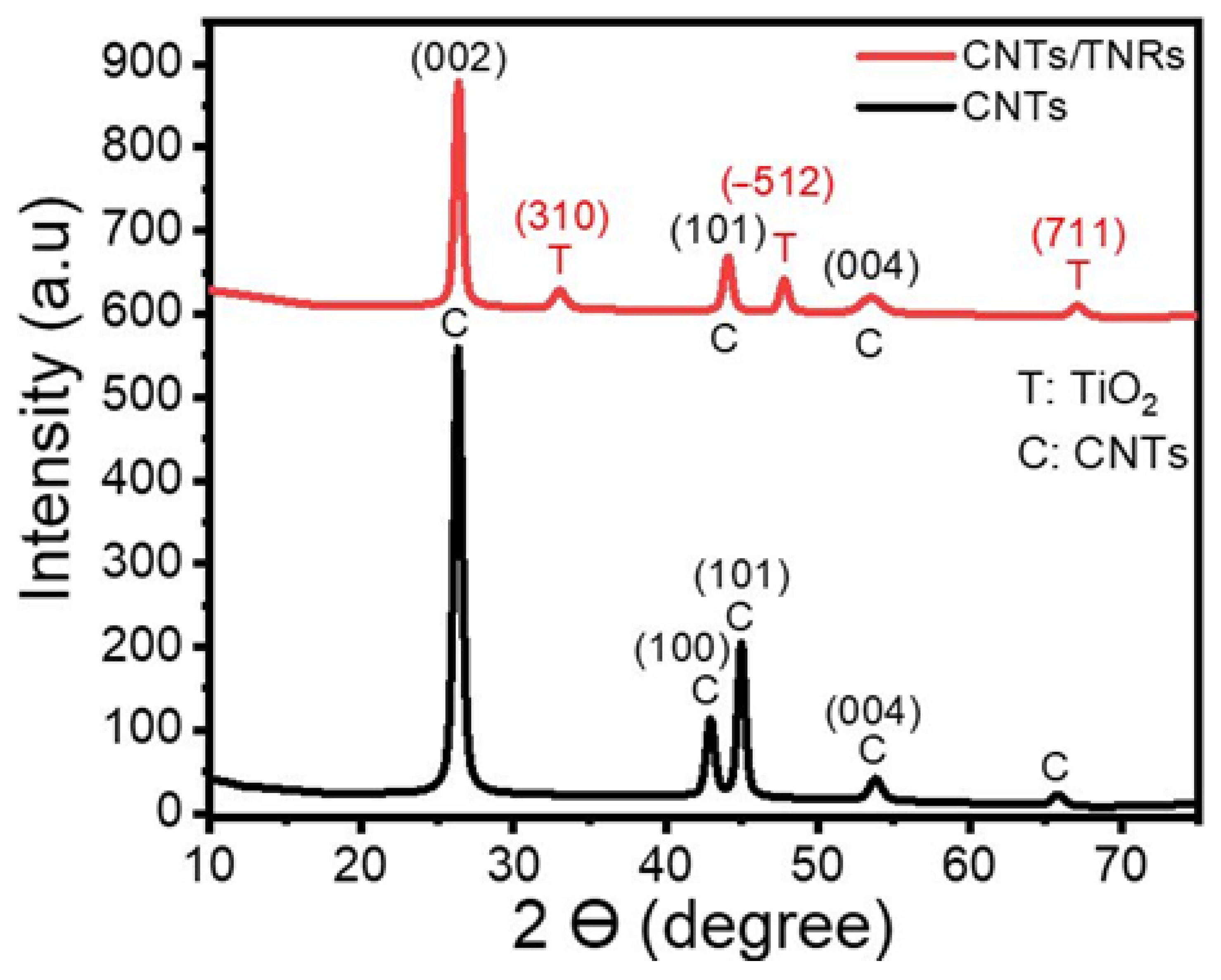
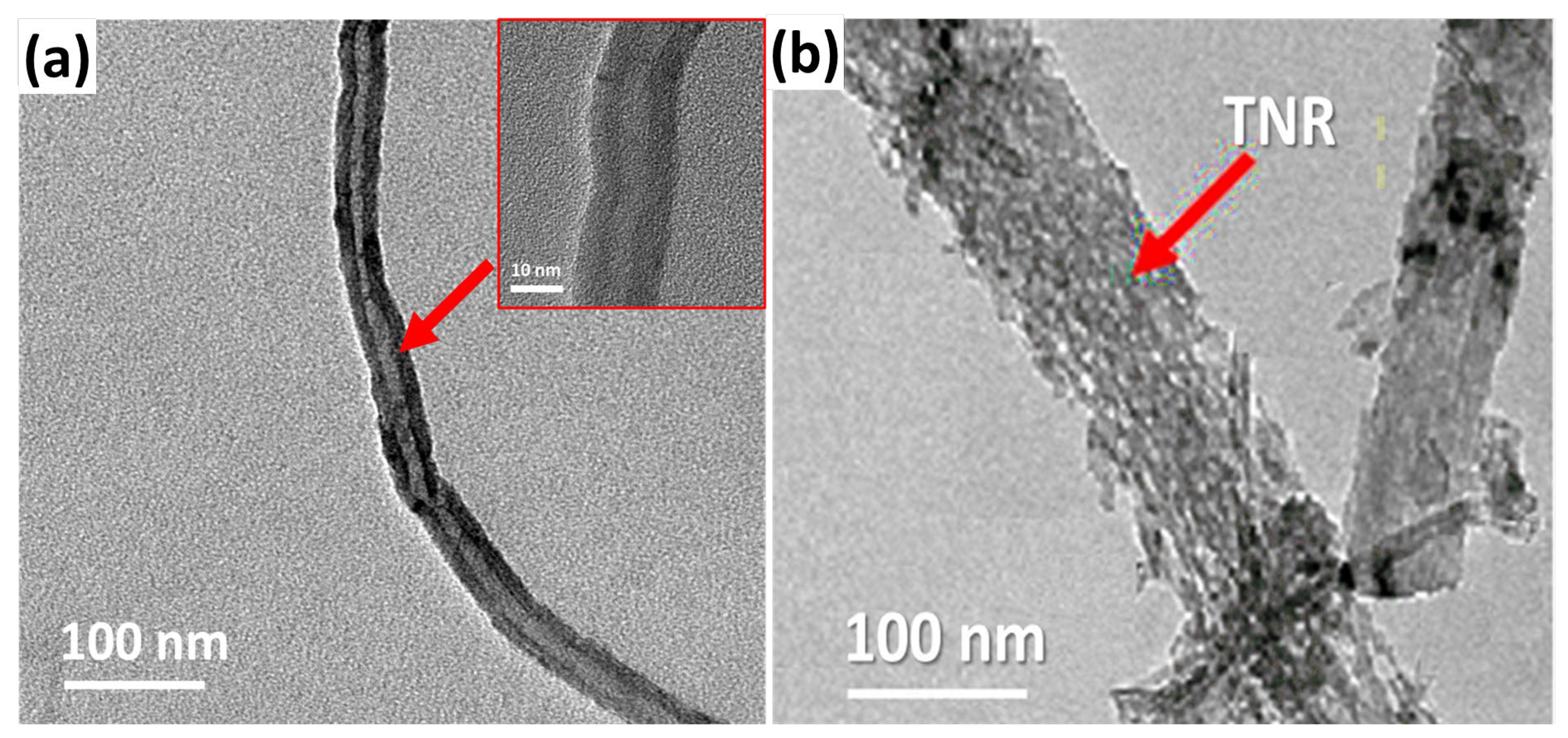

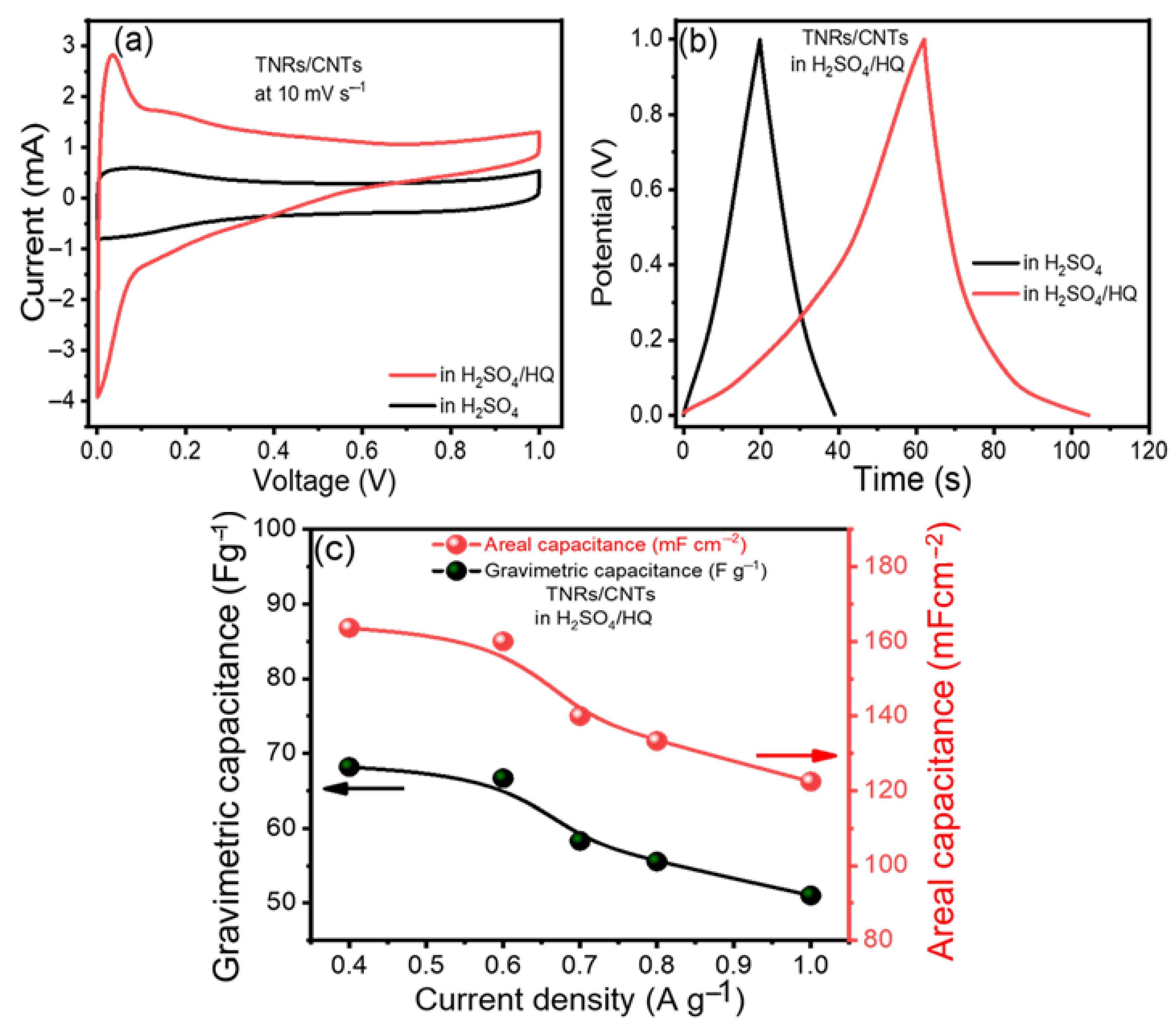
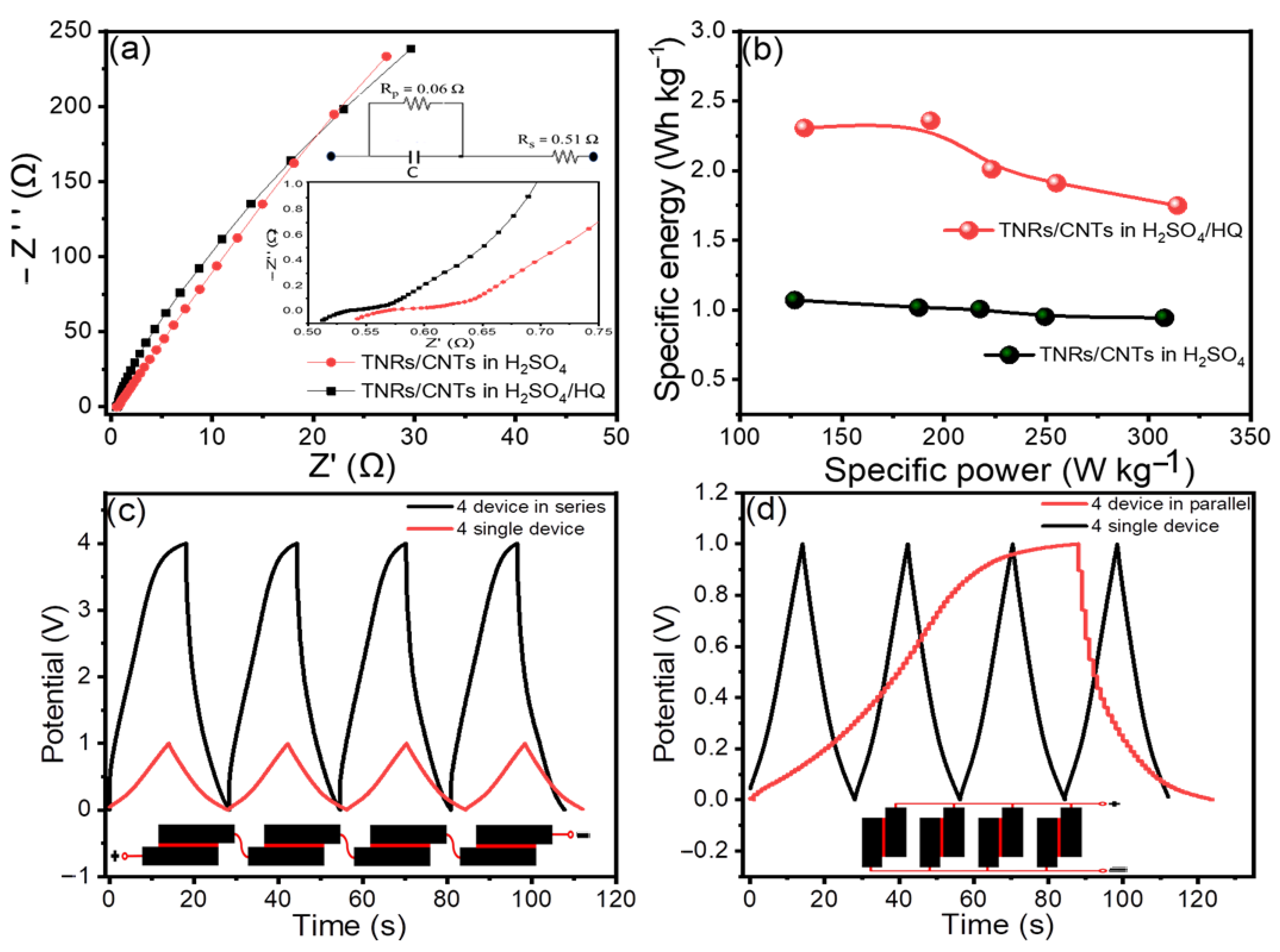
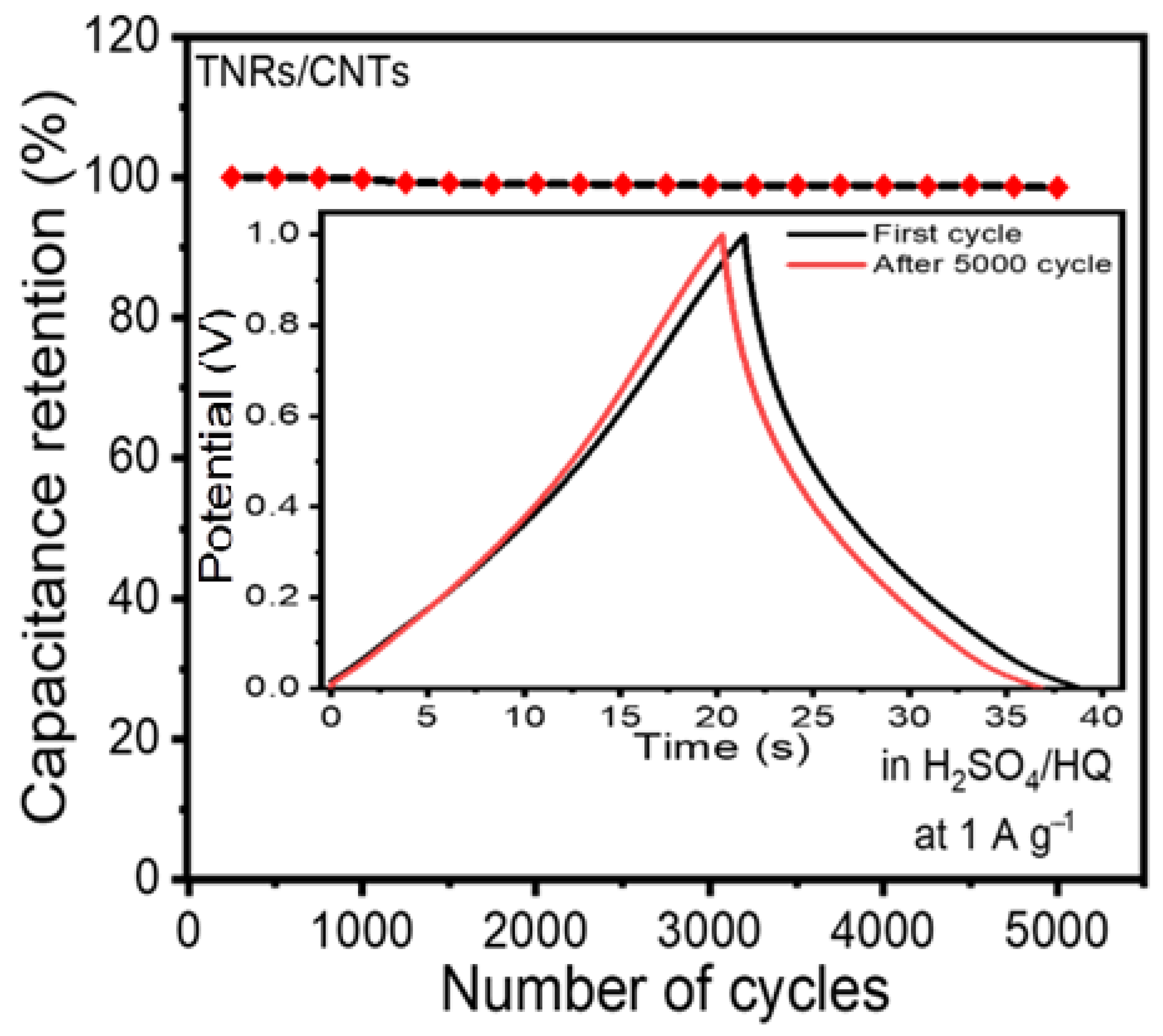
| CNTs | TNRs/CNTs | ||||||||||
|---|---|---|---|---|---|---|---|---|---|---|---|
| CNTs | TiO2—B | ||||||||||
| Peaks | 2ϴ (Deg) | 26.32 | 42.91 | 44.94 | 65.74 | 26.35 | 44.05 | 53.48 | 33.0020 | 47.7603 | 67.0194 |
| Planes | (002) | (100) | (101) | (004) | (002) | (101) | (004) | (310) | (−512) | (711) | |
| CS (Å) | 146.78 | 153.56 | 177.04 | 106.52 | 168.03 | 154.18 | 63.74 | 99.09 | 156.31 | 113.98 | |
| d-spacing (Å) | 3.386 | 2.108 | 2.017 | 1.705 | 3.383 | 2.056 | 1.713 | 2.714 | 1.904 | 1.396 | |
| Dislocation density (δ) × 10−5 (Å−2) | 4.64 | 4.24 | 3.19 | 8.81 | 3.54 | 4.21 | 24.61 | 10.18 | 4.09 | 7.70 | |
| Texture Coefficient (TC) | 2.538 | 0.442 | 0.895 | 0.125 | 2.275 | 0.562 | 0.163 | 0.875 | 1.579 | 0.546 | |
| Microstrain only (%) | 1.154 | 0.686 | 0.570 | 0.800 | 1.006 | 0.667 | 1.344 | 1.370 | 0.609 | 0.6126 | |
Disclaimer/Publisher’s Note: The statements, opinions and data contained in all publications are solely those of the individual author(s) and contributor(s) and not of MDPI and/or the editor(s). MDPI and/or the editor(s) disclaim responsibility for any injury to people or property resulting from any ideas, methods, instructions or products referred to in the content. |
© 2023 by the authors. Licensee MDPI, Basel, Switzerland. This article is an open access article distributed under the terms and conditions of the Creative Commons Attribution (CC BY) license (https://creativecommons.org/licenses/by/4.0/).
Share and Cite
BinSabt, M.; Shaban, M.; Gamal, A. Nanocomposite Electrode of Titanium Dioxide Nanoribbons and Multiwalled Carbon Nanotubes for Energy Storage. Materials 2023, 16, 595. https://doi.org/10.3390/ma16020595
BinSabt M, Shaban M, Gamal A. Nanocomposite Electrode of Titanium Dioxide Nanoribbons and Multiwalled Carbon Nanotubes for Energy Storage. Materials. 2023; 16(2):595. https://doi.org/10.3390/ma16020595
Chicago/Turabian StyleBinSabt, Mohammad, Mohamed Shaban, and Ahmed Gamal. 2023. "Nanocomposite Electrode of Titanium Dioxide Nanoribbons and Multiwalled Carbon Nanotubes for Energy Storage" Materials 16, no. 2: 595. https://doi.org/10.3390/ma16020595
APA StyleBinSabt, M., Shaban, M., & Gamal, A. (2023). Nanocomposite Electrode of Titanium Dioxide Nanoribbons and Multiwalled Carbon Nanotubes for Energy Storage. Materials, 16(2), 595. https://doi.org/10.3390/ma16020595








